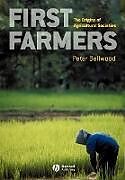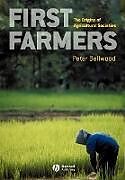First Farmers
Einband:
Kartonierter Einband
EAN:
9780631205661
Genre:
Biology
Autor:
Peter Bellwood
Herausgeber:
John Wiley & Sons
Erscheinungsdatum:
05.10.2004
Autorentext
Peter Bellwood is Professor of Archaeology at the Australian National University. He is the author of Examining the Farming/Language Dispersal Hypothesis (co-edited with Colin Renfrew, 2003), Prehistory of the Indo-Malaysian Archipelago (2nd edition 1997), The Polynesians: Prehistory of an Island People (1987), and Man's Conquest of the Pacific: The Prehistory of Southeast Asia and Oceania (1986).
Klappentext
First Farmers examines the reasons for the multiple primary origins of agriculture, looks at relations between hunter-gatherers and farmers, and addresses issues of agricultural adoption, the origins and dispersal histories of language families, and the dispersal histories of biological populations. Bellwood offers discussion of regional agricultural origins in, and dispersals out of, these areas: the Middle East, central Africa, China, New Guinea, Mesoamerica, and the northern Andes. The linguistic survey covers the origins and dispersals of major language families such as Indo-European, Austronesian, Sino-Tibetan, Niger-Congo, and Uto-Aztecan.
Zusammenfassung
Offers readers an understanding of the origins and histories of early agricultural populations in various parts of the world. This book focuses on agricultural origins in and dispersals out of the Middle East, central Africa, China, New Guinea, and the northern Andes. It examines the reasons for the multiple primary origins of agriculture.
Inhalt
Detailed Contents.List of Figures.List of Tables.Preface.1 The Early Farming Dispersal Hypothesis in Perspective.The disciplinary players.Broad perspectives.Some key guiding principles.2 The Origins and Dispersals of Agriculture: Some Operational Considerations.The significance of agriculture: productivity and population numbers.Why did agriculture develop in the first place?.The significance of agriculture vis-a-vis hunting and gathering.Under what circumstances might hunters and gatherers have adopted agriculture in prehistory?.Group 1: The "niche" hunter-gatherers of Africa and Asia.Group 2: The "unenclosed" hunter-gatherers of Australia, the Andamans and the Americas.Group 3: Hunter-gatherers who descend from former agriculturalists.Why do ethnographic hunter-gatherers have problems with agricultural adoption? A comparative view.To the archaeological record.3 The Beginnings of Agriculture in Southwest Asia.The domestication of plants in the Fertile Crescent.The hunter-gatherer background in the Levant, 19,000 to 9500 BC.The Pre-Pottery Neolithic and the increasing dominance of domesticated crops.How did cereal domestication begin in Southwest Asia?.The archaeological record in Southwestern Asia in broader perspective.The Pre-Pottery Neolithic A.The Pre-Pottery Neolithic B.The real turning point in the Neolithic Revolution.4 Tracking the Spreads of Farming Beyond the Fertile Crescent: Europe and Asia.The spread of the agricultural economy through Europe.Southern and Mediterranean Europe Cyprus, Turkey and Greece.The Balkans.The Mediterranean.The Danubians and the northern Mesolithic.The TRB and the Baltic.The British Isles.Hunters and farmers in prehistoric Europe.Agricultural dispersals from Southwest Asia to the east.Central Asia.The Indian Subcontinent.The domesticated crops of the Indian Subcontinent.Regional trajectories from hunter-gathering to farming in South Asia.The consequences of Mehrgarh.Western India: Balathal to Jorwe.Southern India.The Ganges Basin and Northeastern India.Europe and South Asia in a nutshell.5 Africa: An Independent Focus of Agricultural Development?.The spread of the Southwest Asian agricultural complex into Egypt.The origins of the native African domesticates.The development and spread of agriculture in Sub-Saharan Africa.6 The Beginnings of Agriculture in China.Environmental factors and the domestication process in China.The archaeology of early agriculture in China.The archaeological record of the Early Neolithic in the Yellow and Yangzi Basins.Later developments (post 5000 BC) in the Chinese Neolithic.The spread of agriculture south of Zhejiang.7 The Spread of Agriculture into Southeast Asia and Oceania.The background to agricultural dispersal in Southeast Asia.Early farmers in Mainland Southeast Asia.Early farmers in Taiwan and Island Southeast Asia.Early farmers in the Pacific.The New Guinea agricultural trajectory and its role in Pacific colonization.8 Early Agriculture and its Spread in the Americas.Some necessary background.The geography of early agriculture, and general cultural trajectories.Current opinion on agricultural origins in the Americas.The domesticated crops.Maize.The other crops.Early pottery in the Americas.Early farmers in the Americas.The Andes.Amazonia.Middle America (with Mesoamerica).The Southwest.Thank the Lord for the freeway (and the pipeline).Immigrant Mesoamerican farmers in the Southwest?.Independent agricultural origins in the Eastern Woodlands.9 What Do Language Families Mean for Human Prehistory?.Language families and how they are studied.Issues of phylogeny and reticulation.The identification and phylogenetic study of language families.Introducing the players.How do languages and language families spread?.How do languages change through time?.Macrofamilies, and more on the time factor.Languages in competition - language shift.Languages in competition - contact-induced change.10 The Spread of Farming: Comparing the Archaeology and the Linguistics.Western and Central Eurasia, and Northern Africa.Indo-European.Indo-European from the Pontic Steppes?

Leider konnten wir für diesen Artikel keine Preise ermitteln ...
billigbuch.ch sucht jetzt für Sie die besten Angebote ...
Die aktuellen Verkaufspreise von 6 Onlineshops werden in Realtime abgefragt.
Sie können das gewünschte Produkt anschliessend direkt beim Anbieter Ihrer Wahl bestellen.
Loading...
Die aktuellen Verkaufspreise von 6 Onlineshops werden in Realtime abgefragt.
Sie können das gewünschte Produkt anschliessend direkt beim Anbieter Ihrer Wahl bestellen.
| # | Onlineshop | Preis CHF | Versand CHF | Total CHF | ||
|---|---|---|---|---|---|---|
| 1 | Seller | 0.00 | 0.00 | 0.00 |
